For going back to Japanese pages, press  buttons.
buttons.
 Editor's Note (Toru Nakagawa, Jun. 16, 2016)
Editor's Note (Toru Nakagawa, Jun. 16, 2016)
This is the paper and the presentation I submitted to the TRIZCON2016 held on Mar. 3-5, 2016 in USA. In the present page in English I am posting the paper published in the Proceedings, and the presentation slides and the video record of the presentation, both submitted beforehand. Japanese versions of the paper and the slides are posted in the Japanese page.
TRIZCON in the USA were going to be held this year on March 3-5 in New Orleans, LA, after several years of interval. As I am a Lifetime Member of the Altshuller Institute  since 1998 and have communicated several times on the subject of making the Altshuller Institute active again, I was planning to attend at TRIZCON and to give this presentation. However, starting mid November last year I had a pain of nerve in my left leg, and mid February this year I could walk for just a few minutes before stopping on the road. Hence I had to give up making a trip to USA two weeks before the Conference. Under the permission by the Conference Office, I made a video recording of my presentation and submitted it to TRIZCON a week beforehand. The video presentation, however, was not shown publicly at the TRIZCON, because the presentations by other authors were given at the sessions. --- On my inquiry after the Conference, the TRIZCON Office told me "Nakagawa's paper is officially published in the TRIZCON2016 Proceedings. The presentation slides and the video are also submitted for publication at the Conference." Thus I am posting them here publicly. --- The pain in my leg has gone around Mar. 20, fortunately, as the result of the rehabilitation treatment, and I am now happy to have activities almost as usual.
since 1998 and have communicated several times on the subject of making the Altshuller Institute active again, I was planning to attend at TRIZCON and to give this presentation. However, starting mid November last year I had a pain of nerve in my left leg, and mid February this year I could walk for just a few minutes before stopping on the road. Hence I had to give up making a trip to USA two weeks before the Conference. Under the permission by the Conference Office, I made a video recording of my presentation and submitted it to TRIZCON a week beforehand. The video presentation, however, was not shown publicly at the TRIZCON, because the presentations by other authors were given at the sessions. --- On my inquiry after the Conference, the TRIZCON Office told me "Nakagawa's paper is officially published in the TRIZCON2016 Proceedings. The presentation slides and the video are also submitted for publication at the Conference." Thus I am posting them here publicly. --- The pain in my leg has gone around Mar. 20, fortunately, as the result of the rehabilitation treatment, and I am now happy to have activities almost as usual.
The paper describes the CrePS Methodology (i.e., General Methodology of Creative Problem Solving) from the overall perspective. Last year I had many chances of talking about CrePS and USIT (see the guide to my papers & presentatons in 2015  ), starting with the ICSI Keynote at Hong Kong in July, presentations at Japan TRIZ Symposium (in September), at Japan Creativity Society Conference (early October), at ETRIA TFC in Berlin (late October), and the full paper for Journal of JCS (final submision late December). There, I have put stress on USIT, i.e., USIT is a concise and overall process of creative probelm solving executing the Six-Box Scheme, and demonstrates the feasibility of integrating and unifying various problem solving methods into the CrePS methodology. At the occasion of talking to the TRIZ specialists and users in USA (after several years of interval) I wanted to present my thoughts from overall viewpoints.
), starting with the ICSI Keynote at Hong Kong in July, presentations at Japan TRIZ Symposium (in September), at Japan Creativity Society Conference (early October), at ETRIA TFC in Berlin (late October), and the full paper for Journal of JCS (final submision late December). There, I have put stress on USIT, i.e., USIT is a concise and overall process of creative probelm solving executing the Six-Box Scheme, and demonstrates the feasibility of integrating and unifying various problem solving methods into the CrePS methodology. At the occasion of talking to the TRIZ specialists and users in USA (after several years of interval) I wanted to present my thoughts from overall viewpoints.
My intention of the present paper is expressed clearly in its title. I am going to talk What I want to establish in the name of 'CrePS'. In what sense, is it the methodology superseeding TRIZ? Why is it necessary and desirable to establish CrePS? How are we going to establish it? Will it be possible, really? I am raising these questions and am answering them one by one in the paper. My answer is briefly summarized in the Abstract of the paper. Please also refer the Table of Contents shown below.
Table of Contents
Paper
Abstract |
|
Slides
|
| 1. Introduction |
|
Introduction |
2. What is CrePS? (General Methodology of Creative Problem Solving)
2.1 CrePS: Its definition by requirements
2.2 Basic plan of CrePS: Adopting the Six-Box Scheme paradigm of creative problem solving as the framework of the methodology
2.2.1 Concept of the Six-Box Scheme: Its definition in the dataflow representation.
2.2.2 Six-Box Scheme model of creative problem solving process
2.3 Positioning and practices of CrePS in the Real world
2.4 Our new big target: To establish, proliferate, and apply CrePS
|
|
Part 1. What
shall we establish? |
3. Why do we need a general methodology CrePS ?
3.1 Understanding the present situation: Defects and weakness of the conventional methods for creative problem solving (including TRIZ)
3.1.1 Too many and different methods exist chaotically
3.1.2 Conventional basic paradigm, 'Four-Box Scheme', of problem solving is not effective enough
3.1.3 Contributions of TRIZ and its limitation
3.1.4 Difficulty of integrating various existent methods
3.2 Understanding ideal systems: Image of ideal methods for creative problem solving.
3.2.1 Image of ideal from the TRIZ viewpoint of application areas: Insights of fields of application of TRIZ
3.2.2 Image of ideal anticipated by the fields of application: Requirement of unified methodology instead of individual methods
3.2.3 Understanding the ideal system: What is needed after all?
|
|
Part 2. Why
do we need to estabish it? |
4. How? -- How can we build and use the general methodology CrePS?
4.1 Brief history of developing the concept of the CrePS methodology
4.2 Possibility of integrating various methods by use of the Six-Box Scheme
4.3 USIT: A concise, easy-to-learn, whole process executing the Six-Box Scheme:
4.3.1 Overall view of the USIT process
4.3.2 USIT Manual and Collection of USIT Case Studies
4.3.3 USIT Case Study: (4) Picture hanging kit problem
4.3.4 USIT Case Study: (3) Saving water on a toilet system: Solving a Physical contradiction
4.4 Tasks for integrating various methods into the CrePS methodology. Problem recognition/definition and solution implementation in the Real World
|
|
Part 3. How
can we establish it? |
5. Concluding Remarks
5.1 What are made clear in the present work?
5.2 Future tasks and challenges
References |
|
Concluding
Remarks |
 Presentation Slides ==> PDF
Presentation Slides ==> PDF 
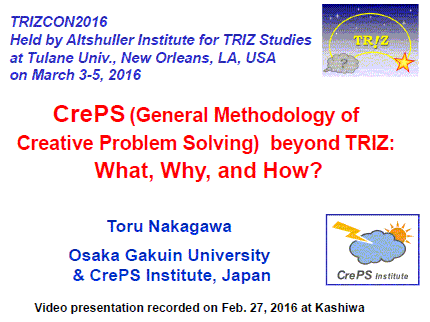
Introduction
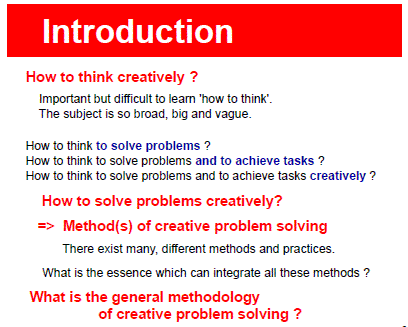
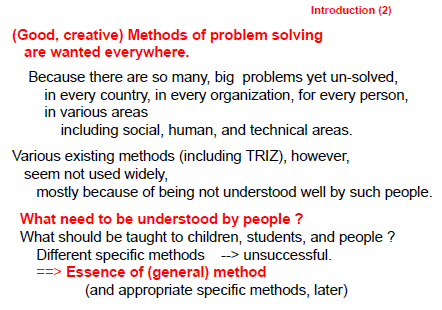
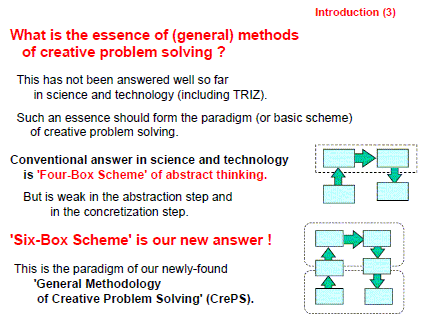
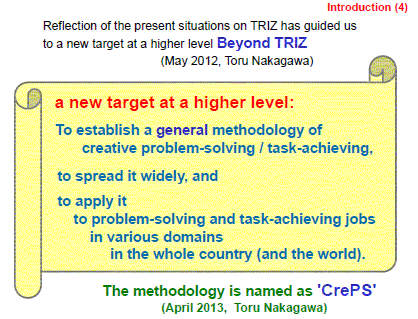
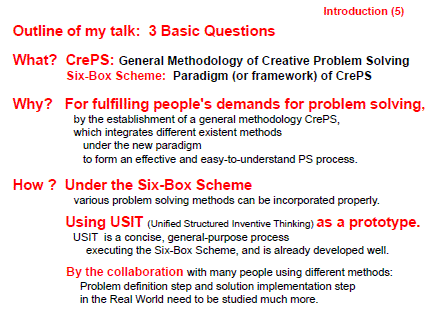
Part 1. What shall we establish?
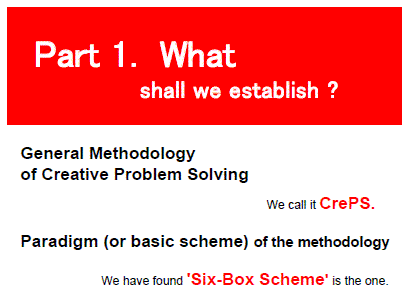
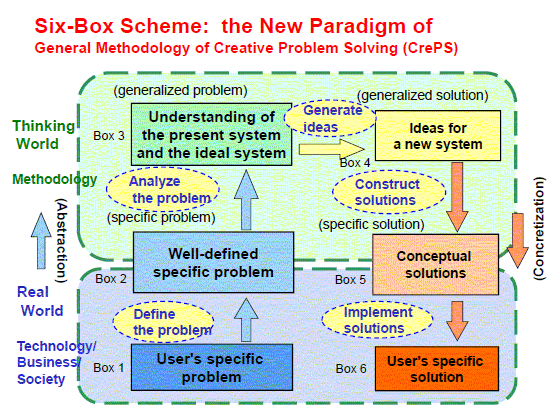
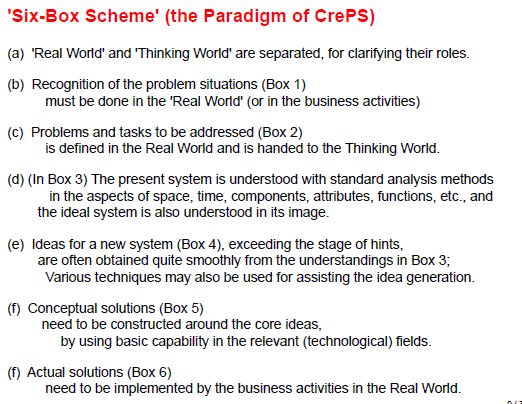
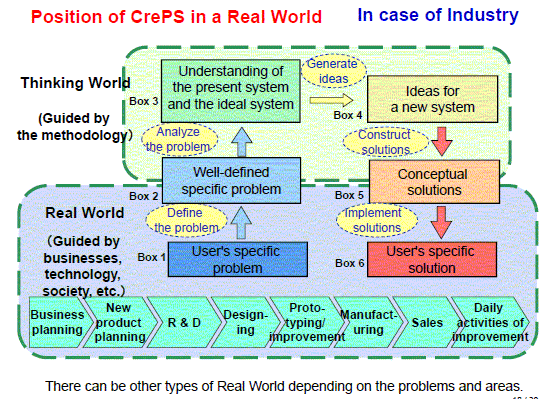
Part 2. Why do we need to estabish it?
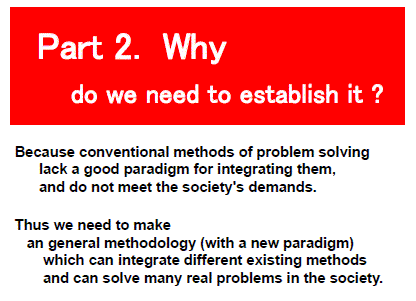
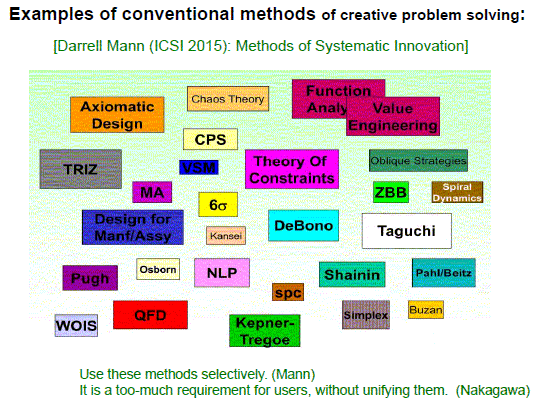
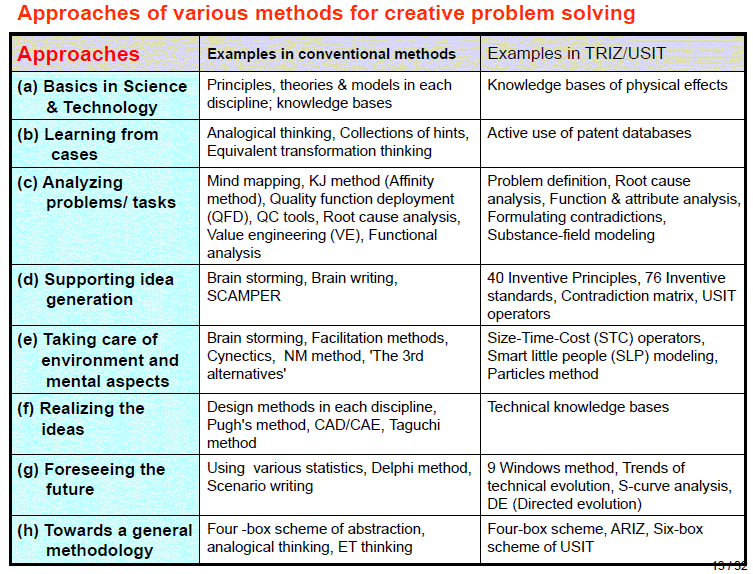
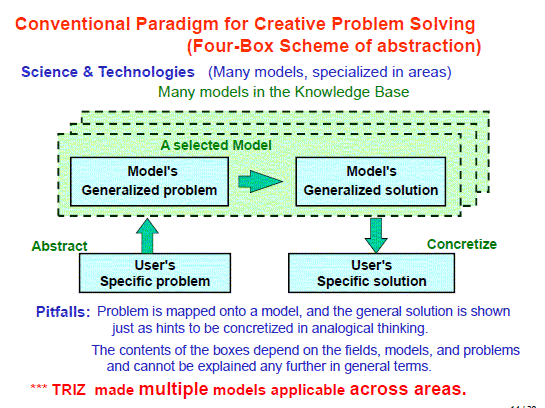
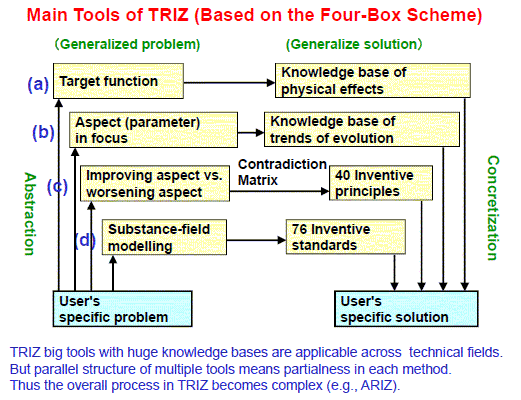
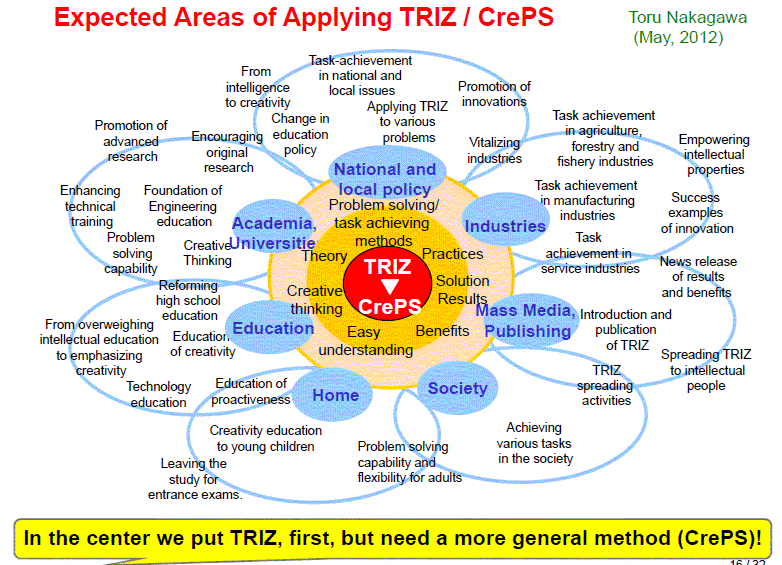
Part 3. How can we establish it?
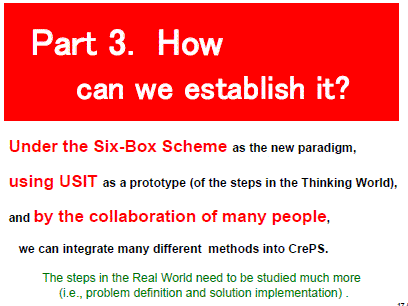
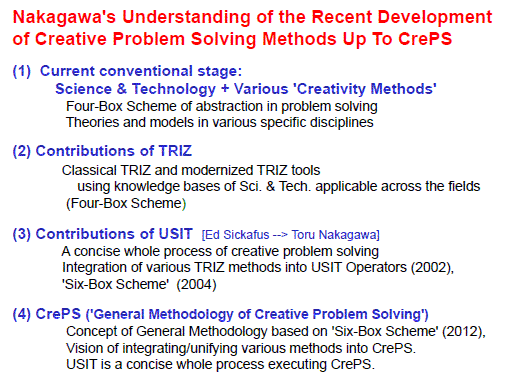
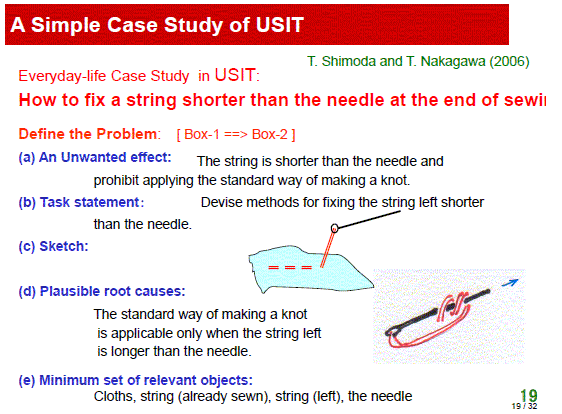
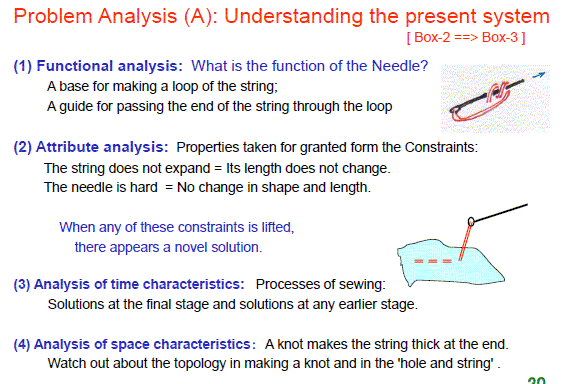
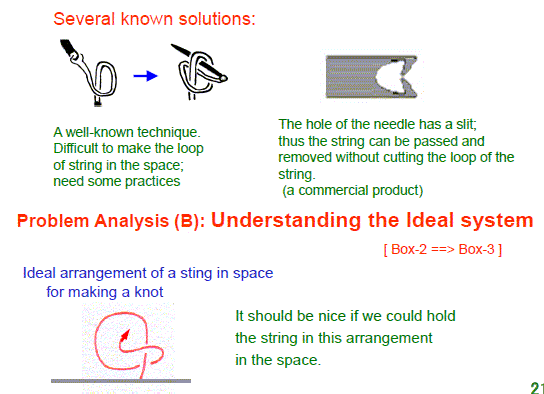
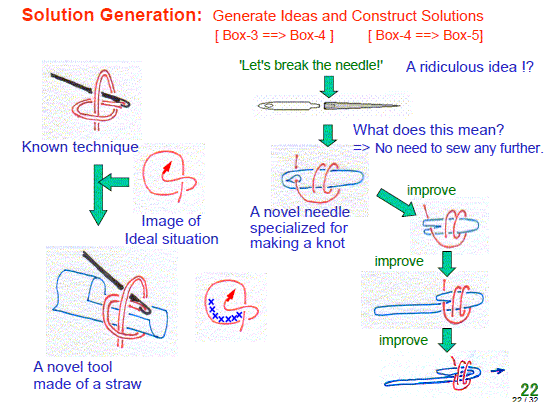
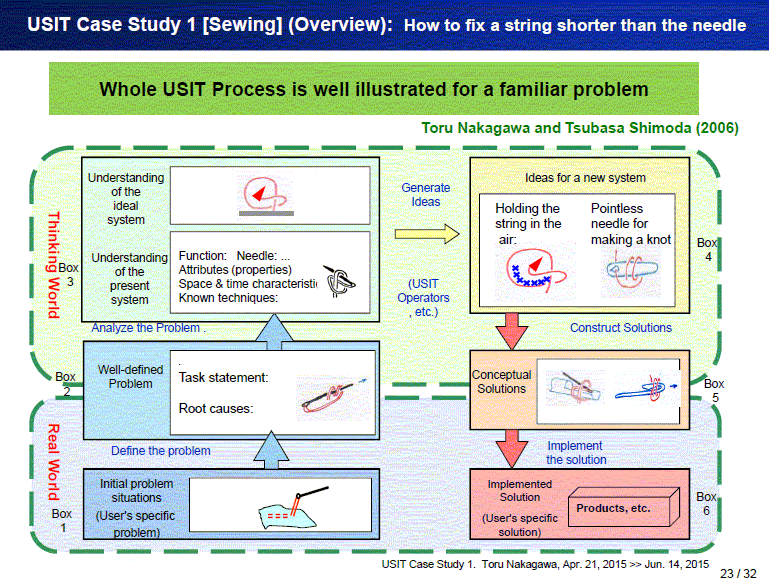
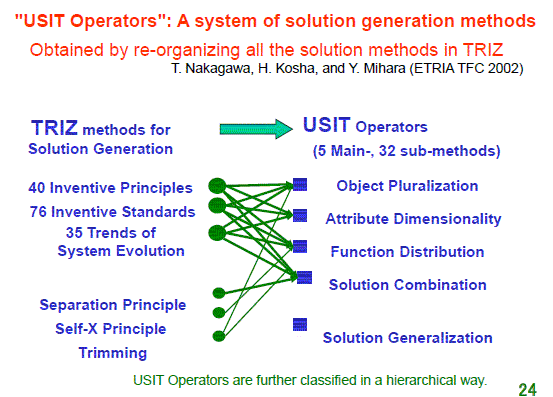
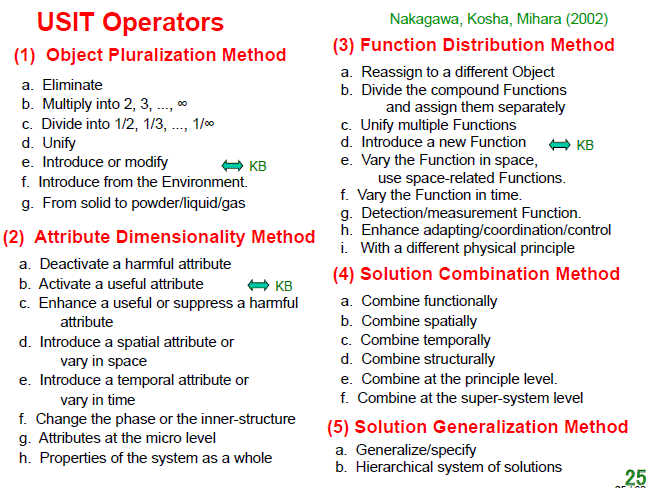
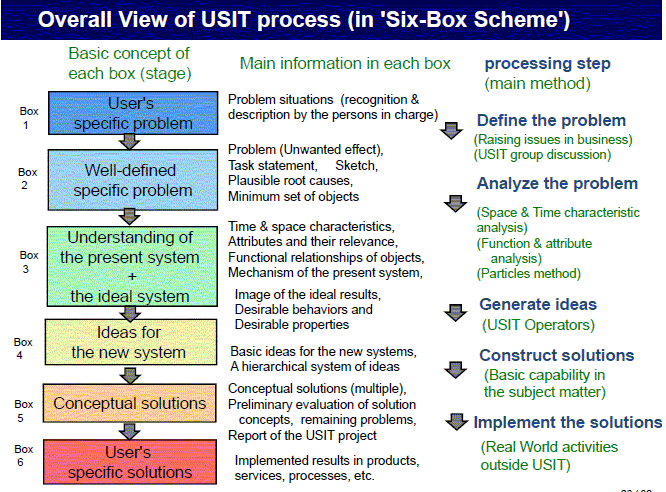
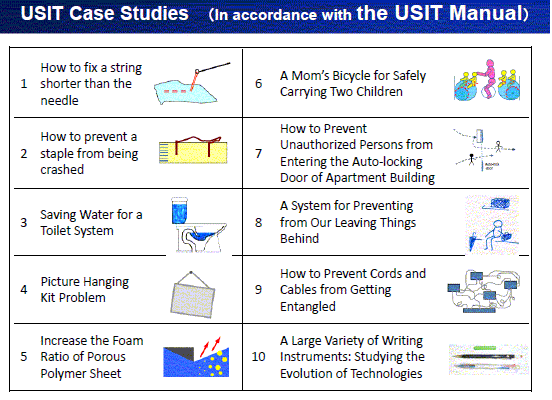
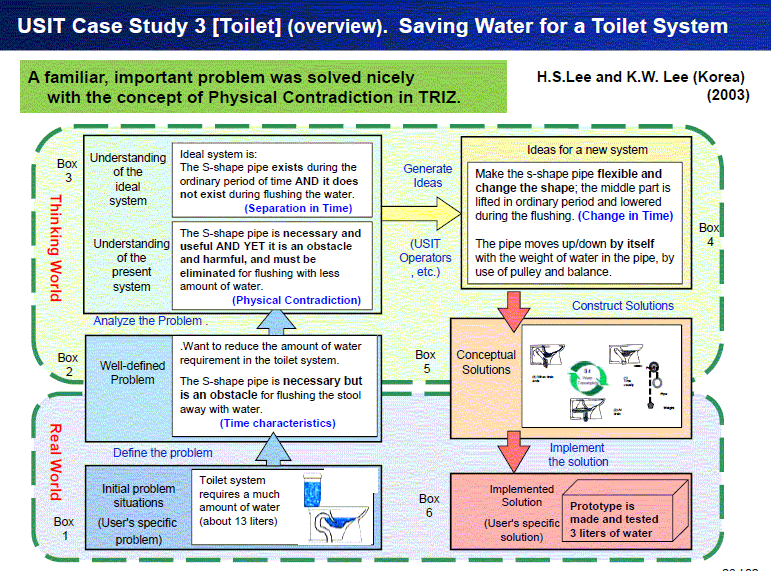
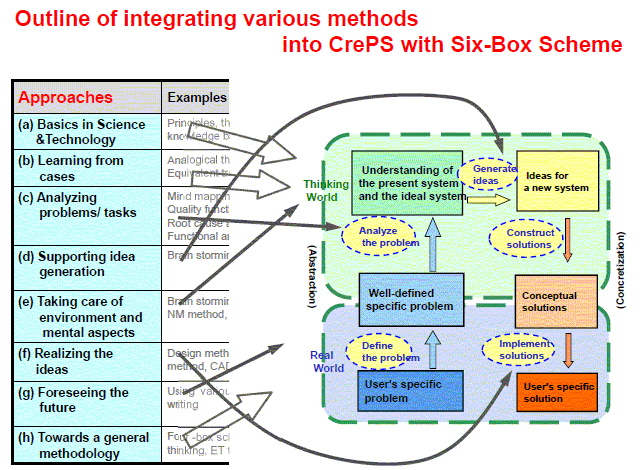
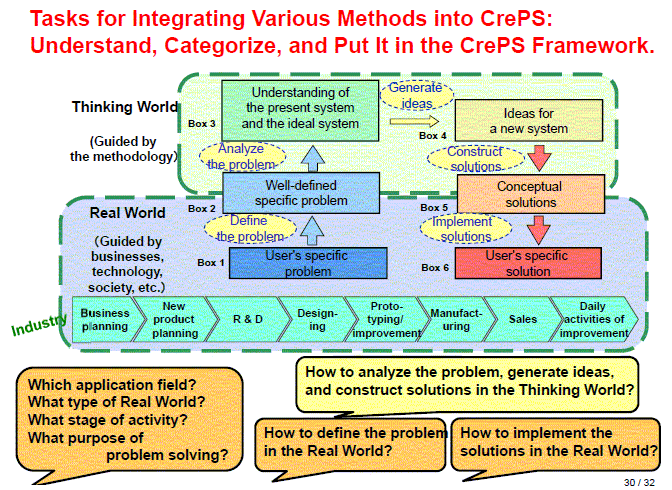
Concluding Remarks
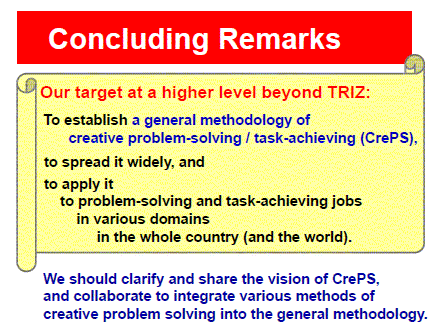
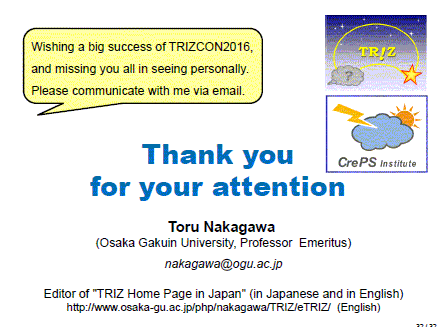
 Paper ==> PDF
Paper ==> PDF 
CrePS (General Methodology of Creative Problem Solving) beyond TRIZ:
What, Why, and How?
Toru Nakagawa (Osaka Gakuin University, Japan)
Submitted to TRIZCON2016 (Annual Conference of the Altshuller Institute for TRIZ Studies),
held at New Orleans, LA, USA, Mar. 2-5, 2016
Abstract
This paper proposes to establish a 'General Methodology of Creative Problem Solving' (abbreviated as CrePS) and answers the three fundamental questions:
What? -- CrePS is a general methodology which integrates various methods related to creative problem solving / task achieving and is applicable widely to different types of problems in technical and non-technical areas. The 'Six-Box Scheme' is adopted as the new basic paradigm of creative problem solving; this forms the framework of CrePS.
Why? -- Many conventional methods, including TRIZ, could not find a useful framework/paradigm of creative problem solving, and compete one another. Thus they, even as the whole, could not respond to the big needs of the whole society, namely to solve problems and achieve tasks of various types of themes in different areas, to develop methods for such work, and to cultivate people to be capable for such work. We need to fill such needs of the whole society with CrePS.
How? -- Using the 'Six-Box Scheme', we define a problem in the 'Real World', generate conceptual solutions to the problem in the Thinking World, and then implement the solutions in the 'Real World'. Among the three principal processes, the central process of generating conceptual solutions in the Thinking World is the core. For the core process, USIT (Unified Structured Inventive Thinking), which delivered the Six-Box Scheme, has been developed already and is a model to integrate and unify various relevant methods in the Thinking World. For the processes in the Real World, i.e., the problem definition and solution implementation processes, conventional methods should be categorized according to their application themes and areas, in order to prepare for integrating them. By the collaborative work of researchers and promoters of various methods, CrePS should be established, proliferated and applied widely.
1. Introduction
The present paper is addressed generally to the methods of thinking for solving problems and for achieving tasks, especially to the methods for creative problem solving and task achieving, methods for improving the creative capability and various methods for applying those methods to the real problems in the world. Such methods can guide various research and development in science and technology and can be applied to solve many problems in society and in business and also familiar problems in everyday life.
Such methods have been tried in different ways since old days, but they are not systematized well so far [1]. A variety of partial methods/techniques are taught and used in different fields and are competing one another. There is no standard courses/textbooks for teaching how to solve problems creatively at school, in universities, and in companies/society.
In such a situation, TRIZ (Theory of Inventive Problem Solving) [2-4] has been introduced since 1990s to the Western world. It was developed by Genrikh Altshuller in a private section of the former USSR by extracting information from a large body of patent database and organizing them into a number of techniques and knowledgebases in science and technology. It was conventional that science and technology were apt to organize their knowledge systems in their fields of specialty and to address to problem solving in their own fields. TRIZ, on the contrary, delivered knowledgebases and techniques which can be applied widely in technology across the fields. Nowadays, however, TRIZ has not been recognized well in its advanced features in industries and in academia and is declining to the state of just one of many invention-oriented techniques.
Such a chaotic overall situation of these creative problem solving methods is caused by the lack of a total system which contain all the relevant methods and systematizing them with a clear framework structure. Some concept of systematization and some scheme of framework structure are required, first of all. Once they were found, various conventional methods could be organized properly, taught in a systematic manner, and applied actively in many different fields. "Let's try to find such novel concept, scheme, and system in general and create a system of creative problem solving methods and their practical applications", the present author has been proposing since 2012 [5-8].
He has named the new concept as CrePS (‘General Methodology of Creative Problem Solving’). It is a higher-level and widely-applicable generalized methodology which systematizes a large variety of creative problem solving/task achieving methods, creativity methods, technology development methods, etc. As the framework of such a system, the present paper proposes to adopt the 'Six-Box Scheme' of creative problem solving [9-10]. It overcomes the weakness in the 'Four-Box Scheme' which has been used widely in science and technology and in TRIZ as well, and shows clear guidelines for thinking creatively and for using in practice. For the practical usage of the Six-Box Scheme in creative problem solving, a concise, general-purpose, and overall process has already been established as USIT (Unified Structured Inventive Thinking). USIT was originally developed by Ed Sickafus in 1985 [11] and was further extended by the present author since 1999. It now has a system of idea generation operators which are reorganized from TRIZ methods, has derived the concept of the Six-Box Scheme, and is demonstrated by many easy-to-understand case studies [12, 8]. The basic plan of CrePS has been derived so far, but the work for integrating and systematizing various conventional methods of creative problem solving into CrePS is just at the starting point to go much much further.
The present paper describes the problem definition and the basic proposal of CrePS so as to answer to the following 3 fundamental questions:
(1) What is CrePS?
(2) Why do we need CrePS? (Responding in the two aspects: from the present problem situations and from the image of the ideal.)
(3) How can we create and use CrePS? (Is it really possible to create CrePS? Are there practical and effective methods in CrePS?)
Finally the paper is concluded with the tasks in the future.
2. What is CrePS? (General Methodology of Creative Problem Solving)
2.1 CrePS: Its definition by requirements
CrePS stands for ‘General methodology of Creative Problem Solving’. It is named, proposed, and under construction by the present author [5-8]. It can be specified by the following requirements:
(a) It systematically integrates a large variety of methods for solving problems creatively, for achieving task creatively, for developing technology/products creatively, and for various other relevant purposes. It is a methodology (i.e., a system of methods and philosophy) at a higher-level of hierarchy of methods.
(b) It is applicable to various fields including technology, society, business, humans, life, etc.
(c) It is applicable to various types of purposes and themes of problem solving and task achieving in such various fields and areas.
(d) It has a solid framework as a methodology and also practically useful/effective in the applications in various fields and themes.
(e) Its philosophy and methods can be taught in a way easy to learn at schools, in universities, in companies, in society, etc., so as to improve people's capability of problem solving and their creativity.
2.2 Basic plan of CrePS: Adopting the Six-Box Scheme paradigm of creative problem solving as the framework of the methodology
For constructing the general methodology CrePS, the present author adopts the Six-Box Scheme paradigm of creative problem solving as the framework of the methodology [8-10, 13]. This framework characterizes the basic plan of CrePS. The Six-Box Scheme is explained in the following:
2.2.1 Concept of the Six-Box Scheme: Its definition in the dataflow representation.
The Six-Box Scheme is a concept representing a framework of general process for solving problems/achieving tasks creatively. It is defined with a dataflow representation, as shown in Fig. 1.
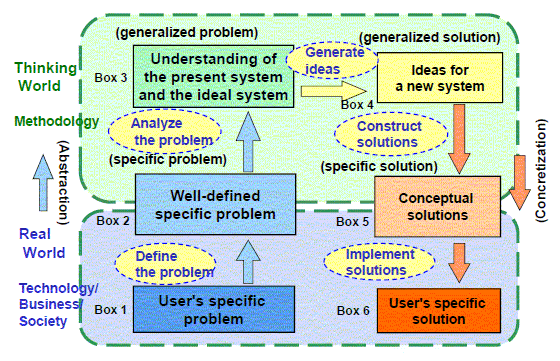
Fig. 1. The Six-Box Scheme: the new basic paradigm for creative problem solving (CrePS) [10]
It is basically characterized with the six 'boxes' in the figure. Each box represents the information which should be obtained at the specific stage in the process. The arrows, on the other hand, represent the process for obtaining the information specified in the next box, by use of the information mostly in the preceding boxes and also by use of other various background information. The arrows show the main stream of the process. In actual practices there may be various subsequent streams, e.g., shortcuts, multiple passes, returns, loops, spiral passes, etc.
It is remarkable that the Six-Box Scheme, hence the CrePS process, is not defined by the flowchart representation/philosophy. Flowcharts put focus on the individual treatment methods in the process, specifying the conditions and orders of them in the process; they do not (or do only subsidiarily) try to specify the information to be obtained in each stage. Due to the definition with the dataflow representation, the Six-Box Scheme process (and hence CrePS) is specified mainly with the information used and obtained in the steps (and only subsidiarily with the treatment procedure). This contributes to define the CrePS process in a generalized and comprehensible manner and robust against differences in applications.
One of the important concepts introduced in the Six-Box Scheme in Fig. 1 is the distinction between the Real World (related to the lower 4 boxes) and the Thinking World (related to the upper 4 boxes). Real World is a model of the real world where various actual activities are carried out containing society, businesses, products, technology, etc. Problem solving starts in the Real World with the recognition of a problem (Box 1) and proceeds to clarify what should be solved (Box 2). And when conceptual solutions are obtained (Box 5), they are tried to be implemented into real products (or concrete solutions) (Box 6). These processes in the Real World are decided and carried out on the basis of the evaluation criteria related to the real society, business, technology, etc. and in reference to the actual situations.
In the above description, for going from the 'Problem defined to be solved' (Box 2) to the 'Conceptual solutions' (Box 5), we need some process for solving the problem and obtaining/generating solutions. The process sometimes can be done solely in the brain of an individual person. More often, however, especially for larger issues, multiple persons are involved to think over, discuss, figure out, etc. in an cooperative thinking work. Such thinking work needs time and place, away from the busy real world, to concentrate themselves in thinking and to think over with a wider scope and free, creative attitude. The model of such a place of creative thinking work is called as Thinking World.
The Six-Box Scheme guides the process in the Thinking World: Receiving the to-be-solved 'Well defined users' problem' (Box 2) from the Real world, analyzing the problem from the stand points of the present system and of the ideal system (Box 3), generating ideas (Box4), and constructing the Conceptual solutions (Box 5) for returning it to the Real world.
It is also useful to understand the Six-Box Scheme process in terms of three main processes: i.e.,
(1) [Problem definition process] In the Real world, recognizing the problem (Box 1) and defining the Problem to be solved (Box 2).
(2) [Problem solving process in a narrow sense] In the Thinking world, receiving the problem (Box 2), analyzing the problem (Box 3), generating new ideas (Box 4), and constructing the conceptual solutions (Box 5).
(3) [Solution implementation process] In the Real world, receiving the conceptual solutions (Box 5) and implementing them into real products/services etc. (Box 6).
This way of understanding reveals the importance of the two processes (Problem definition and Solution implementation processes) in the Real world as well as the Problem solving process (in a narrow sense) in the Thinking world.
2.2.2 Six-Box Scheme model of creative problem solving process
The process in the Six-Box Scheme is explained below along the steps [8, 10].
In the Real world, various activities jobs, stake-holders, products, etc. are running in parallel. Some problematic situation is recognized, and relevant information is collected. Information in such a stage is called 'User's specific problem' (Box 1). Here, 'user' means the person/organization who is decided to solve the problem.
Examining the problem situations, the user should clarify what is the difficulty in the problem situation and what really needs to be solved creatively. The information at this stage is the 'Well-defined user's specific problem' (Box 2)
The task of solving the problem is handed by the parent project in the Real world to the Problem-solving project (or child project) composed of several members. The Problem-solving project starts to work in the Thinking world. They first review the information delivered by the parent project, i.e., the Problem situations (Box 1), Well defined user's specific problem (Box 2), and also the requests such as constraints, due date, etc.
Next, the problem is analyzed in two main aspects, i.e., understanding the present system and also understanding the ideal system (Box 3). Such analysis is carried out from different view points, including time and space characteristics, object-attribute-function, root causes, mechanisms, etc. For these analyses various special techniques/tools are used, but the information comes solely from the real problem and the knowledge of the real situations. Getting the image of the ideal system at this stage is important to generate good solution ideas later.
Next, at Box 4, we generate various ideas for a new system. Exceeding the stage of simple hints suggested from some other system, they are some basic ideas for a new system, such as introduction or modification of some core components or functions. For obtaining such ideas, various tools/techniques may be used, e.g., checklists, hints, principles, operators, etc. However, our brains usually work actively during the preceding step of understanding the present and the ideal systems so as to think of different ideas smoothly. We list up a lot of ideas thus generated and organize them in a hierarchical system.
Then we construct 'Conceptual solutions' (Box 5) around some core ideas. The term 'Conceptual solutions' remarks the point that they are the solutions resultant of creative/thorough thinking and not yet passed the stages of detailed designing and testing, etc. For constructing creative and effective conceptual solutions at this stage, capability and knowledge in the subject matter field are required over the capability in the problem-solving methodology.
As the final result of the problem-solving project in the Thinking world, the Conceptual solutions (Box 5) are delivered to the parent project in the Real world, and becomes the starting points for implementing them in the form of actual products/services/processes (Box 6). For the implementation, a lot of further activities are required in the Real world, for instance in the case of company activities in a manufacturing industry, prototyping, resolution of secondary problems, experiments, CAE, designing, manufacturing, marketing, etc.
2.3 Positioning and practices of CrePS in the Real world
As shown in the requirements (b)(c) in Section 2.1, CrePS is to be applied to much different problems of various purposes and types in various fields and themes. Hence, the real worlds where our problems exist differ much from one another. If we thought them individually different from others, we would need to handle them from the beginning in each case. In practice, however, there usually exist various preceding cases and studies in relevant fields and purposes. By surveying and organizing such preceding works, models of Real World can be built depending on the application fields and types of problems. For example, for the application to company activities in manufacturing industry, a model of Real World of industrial activities may be shown as in Fig. 6 [7, 13].
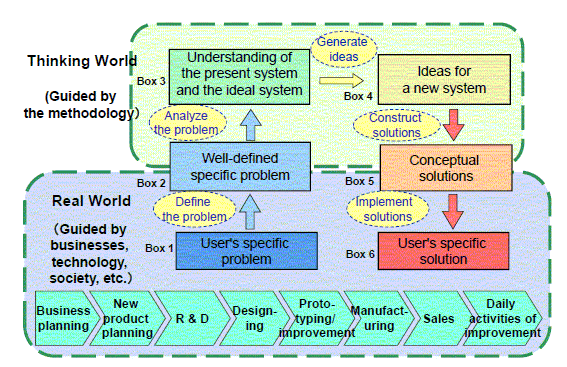
Fig. 2. Six-Box Scheme in a model of Real World: Industrial activities. [13].
The first process in the Real World is to recognize and define a problem (See 2.2.1); i.e., recognizing a problem in the company activities (Box 1), evaluating its importance, and then deciding the problem necessary to solve creatively (Box 2). It is crucial to select and judge which problem is the important one to solve creatively. Problems to solve may differ much in their types depending on the purposes and on the stage of industrial activities as shown in the above figure. The activities in the Thinking world need to be adjusted depending on the problem types, but the basic framework of the Six-Box Scheme is still applicable.
The second process in the Real World starts with the Conceptual solutions (Box 5) received as the result of activities in the Thinking world. The parent project in the Real world should evaluate and select the Conceptual solutions with the criteria and situation in the real world, and should implement them into actual products, services, etc. (Box 6) Such an implementation work may require the whole industrial activities shown in the figure. Creative problem solving can have fruits only after the success of this implementation stage.
2.4 Our new big target: To establish, proliferate, and apply CrePS
Based on the concepts described above, the present author set a new target/vision in 2012 as shown below [5-6]:
"To establish a methodology of creative problem-solving / task-achieving (CrePS),
To spread it widely, and
To apply it to problem-solving and task-achieving jobs in various domains in the whole country (and the world)."
Developing CrePS is not the final goal; we want to proliferate CrePS widely and apply it to various real jobs of solving problems in the world. Therefore, we must build CrePS as a methodology effective and useful for real applications.
3. Why do we need a general methodology CrePS ?
3.1 Understanding the present situation: Defects and weakness of the conventional methods for creative problem solving (including TRIZ)
3.1.1 Too many and different methods exist chaotically
Necessity of solving problems and achieving tasks creatively has been recognized since long; thus there are various works on how to think creatively, education for improving creative capability, techniques for supporting creative problem solving, how to get patents, how to succeed in innovation, etc.
One of review works of such fields is "Encyclopedia of Creative Capability, New Edition" edited by Makoto Takahashi [1]. After an overview of researches on creative capability, the book describes principal 88 techniques for supporting creative thinking. The techniques are classified into 4 categories, i.e., divergent thinking techniques, convergent thinking techniques, integrated thinking techniques, and attitude techniques, and are described individually one after another without further structure.
Learning/mastering such techniques often need direct man-to-man teaching and training. As the results, mutual interaction and integration among the techniques rarely take place. Thus in the world there exist a large number of techniques competing one another, seemingly independently but actually overlapping in the contents. Darrell Mann lists up many relevant techniques as shown in Fig. 3, with no categorization [14].
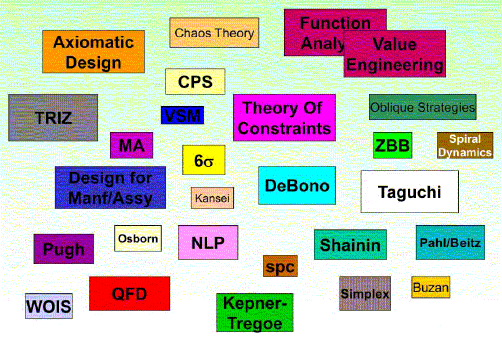
Fig. 3. Examples of various techniques for creativity and innovation. Darrell Mann [14]
Table 1 shows various relevant techniques classified with their approaches or intentions [6]. In the central column, examples of existing relevant techniques are shown according to their principal approaches. In the right-most column, various sub-methods in TRIZ/USIT are also shown. The categorization in the Table does not have any viewpoint for integrating/systematizing the techniques.
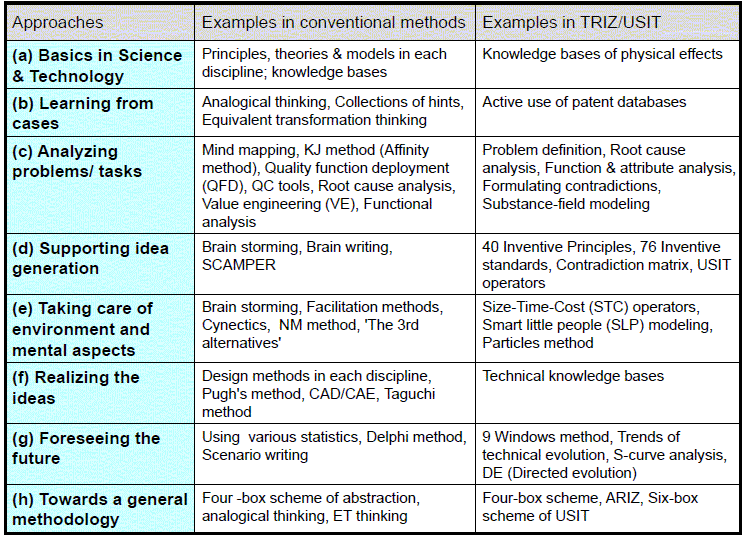
Table 1. Various techniques for creative problem solving categorized with their approaches [6]
3.1.2 Conventional basic paradigm, 'Four-Box Scheme', of problem solving is not effective enough
Science and technology generally use the 'Four-Box Scheme' as their basic paradigm (see Fig. 4) [4].
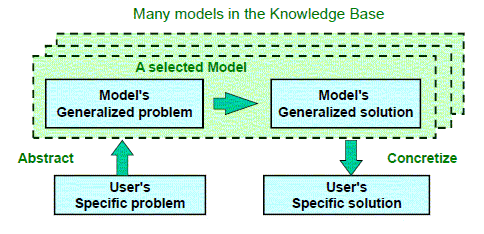
Fig. 4. 'Four-Box Scheme' conventionally used as the basic paradigm in science and technology
This is the standard scheme we have learned and used; especially in mathematics people learn it at school, for example the formula of roots of quadratic equations. On the basis of this 'Four-Box Scheme' of abstraction, theories and models have been constructed and used all over the fields of science and technology. They work effectively for typical problems in each field. For problems requiring creative solutions, however, it is often not obvious which models are effective to apply while sometimes no suitable model actually exists. There are two fundamental weakness in this scheme:
Firstly, the Four-Box Scheme has the fundamental weakness in the abstraction process; namely, the process of abstracting specific problems to generalized problems differs much depending on the individual models. There is no way of explaining the abstraction process, where to go (the target of abstraction) and how to go, in general terms independent from the model. In most cases, users have to choose a model first and then try to fit their problems to patterns of model problems stored in the model.
Secondly, the Four-Box Scheme has the fundamental weakness in the concretization process as well. The model suggests to the user one or more generalized solutions which are stored in the model (or adjusted from them). Then the user has to interpret the essence of the suggestion in terms of his/her own problem, to come up with new ideas, and to construct effective conceptual solutions. These processes depend on the user's capability and experiences, without any explicit guidance.
Thus the Four-Box Scheme has its weak points in the both processes, abstraction and concretization.
3.1.3 Contributions of TRIZ and its limitation
TRIZ, which was developed by Genrikh Altshuller and his followers, has contributed much to improve this situation [2-4]. TRIZ has established several important models by use of big knowledge bases which are very well extracted from patents and technical documents. The models are effective to use across the fields of science and technology (and even more widely). The four principal tools/techniques in TRIZ are based on the Four-Box Scheme individually, as shown in Fig. 5.
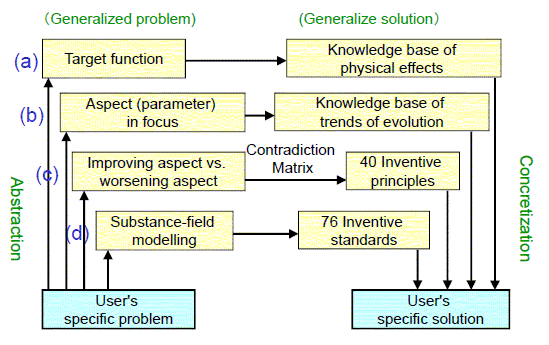
Fig. 5. Four principal tools in TRIZ.
Each tool, (a) - (d), is based on the Four-Box Scheme and has a big knowledgebase [6].
These TRIZ tools commonly have the Four-Box Scheme structure. The user first abstracts his/her specific problem from the aspect shown in the top-left box of the tool. Then by referring to the big knowledgebase of the tool with the clew of the abstract problem, one or several abstract solutions are suggested, which are selected from the many pre-stored solutions or adjusted slightly to match the problem. This means that the user (problem solver) needs to consult with either a handbook, a software tool, or a specialist who has the big knowledgebase of the tool, and also that the generalized solution(s) selected and shown to the user are just suggested as hints.
Having multiple tools with big knowledgebases is a strength of TRIZ, of course. The viewpoint for abstraction in each TRIZ tool, however, is partial (as shown in Fig. 5). Thus for solving (difficult) problems thoroughly, multiple TRIZ tools should be used in combination. This makes the overall process of problem solving with TRIZ complicated and heavy (e.g., ARIZ [3]). As a matter of fact, many TRIZ specialists propose and use their own different versions of TRIZ overall process.
TRIZ has also introduced many important concepts (e.g., concepts of technical systems, contradictions, resources, ideal final results, evolution of technical systems, etc.) and thinking methods, and actually forms a system of thoughts around the evolution of technology. But here we have to skip discussing on them.
3.1.4 Difficulty of integrating various existent methods
TRIZ has been introduced to the Western world since 1990s and has been proliferated to some extent in the world including Japan. However, TRIZ has not been well understood in its significance of advanced philosophy (see 2.3), and is now declining just as one of many invention-oriented problem solving techniques.
In this situation, Darrell Mann is the pioneer who is advocating and practicing to use TRIZ in combination and integration with various methods in the Western culture (see Fig. 3). He proposes to use many techniques with TRIZ at the core and called the methodology as 'Systematic Innovation' [4]. He advises, however, "Even though there are many tools in TRIZ (e.g., 22 chapters of individual tools in his textbook [4]), you can learn and use them one by one whenever you find it necessary." [4] Similarly, he recommends to use various techniques in Fig. 3 selectively for the aspects/problems in a way to make effective use of the strengths of each technique [14]. However, using many big techniques selectively without simplifying or unifying them is obviously too much requirements for ordinary users who are pressed to solve real problems.
Since no guiding principle or framework was found yet, integration of many techniques was impossible by extracting essences of individual methods and unifying them in a way easy to understand. This was the core difficulty in the research of creative problem solving methods so far.
3.2 Understanding ideal systems: Image of ideal methods for creative problem solving.
3.2.1 Image of ideal from the TRIZ viewpoint of application areas: Insights of fields of application of TRIZ
In 2012, the present author was thinking about the areas and themes to which we should apply TRIZ philosophy and tools. As shown in Fig. 6, he put TRIZ at the center, and around it he drew its features and then its target areas to apply. Next in each area he drew big themes desirable to apply TRIZ to.
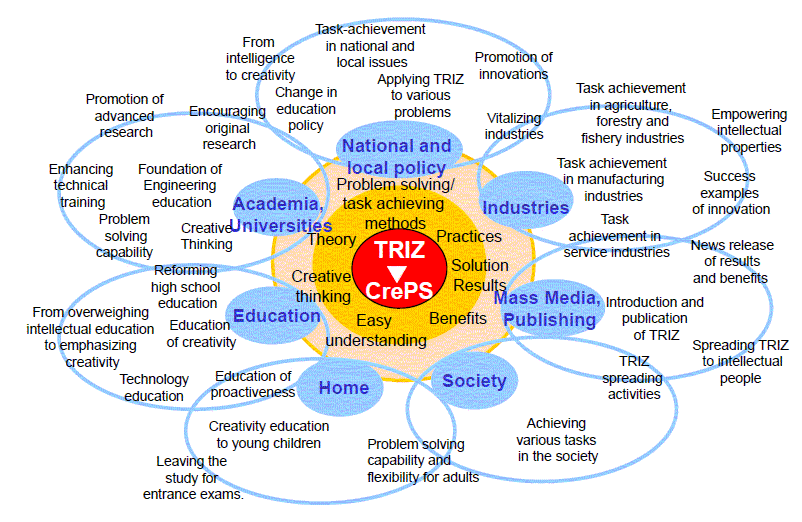
Fig6. Example of areas and themes to which Creative problem solving methodology is expected to apply.
At the center, TRIZ was put initially, but was replaced with the more general methodology CrePS [5, 6]
For example, in academia and in universities, promotion of advanced research (by use of TRIZ), (Reforming) the foundation of engineering education (with the TRIZ philosophy), education of creative thinking, etc. In the field of (school) education, TRIZ is expected to apply for the reformation from overweighing intellectual education to emphasizing creativity, for education of creativity, for education of proactiveness, etc. At home, creativity education to young children is expected with TRIZ. In society, TRIZ is expected to train adults for obtaining problem solving capability and flexibility in thinking. Similarly, in mass media and publishing, in industries, and in national and local policies, etc., there are a lot of important themes to which TRIZ is expected to contribute much.
To all these fields and important themes, TRIZ is expected to be applied, as an ideal situation imagined from the viewpoint of significance of TRIZ. Actual practices and implementation activities of TRIZ, however, are just at their initial stage in some of the themes. We need to go with TRIZ much further in these perspectives.
3.2.2 Image of ideal anticipated by the fields of application: Requirement of unified methodology instead of individual methods
It should be noticed that not only TRIZ but also all other methods of creative problem solving desire to proliferate into and contribute to the variety of fields and themes in Fig. 3. Individual methods may have achieved some partial results for some of the themes. However, even the total of all the methods have only insufficient contributions to these themes. The extensions and also the degrees of proliferation in almost all these themes are quite insufficient.
Considering the root causes of such insufficiency, the present author noticed that they are insufficient because individual creative problem solving methods are trying to pursue the goal individually. They are trying their seeds-oriented approach from the standpoints of individual techniques.
Changing the standpoints, we should think with the needs-oriented approach: what do people need in such application fields and themes? The present author recognized: "People in various application fields need general ways of thinking and their methods (i.e., a general methodology) for solving problems smoothly, effectively, and creatively in various application fields and themes, instead of individual methods." This means that a higher-level methodology is needed which can integrate and unify (i.e., make simple with essences) various individual methods [5].
3.2.3 Understanding the ideal system: What is needed after all?
Following the process of consideration described above, the present author realized that 'A General Methodology of Creative Problem Solving’ is needed. And hence the new target for establishing, proliferating, and applying the new general methodology was set up (see 2.4). And the methodology was named CrePS (General Methodology of Creative Problem-Solving/Task- Achieving) [6].
Sometimes the term 'Problem solving' is used in short in place of more formal term 'Problem solving / Task achieving'. 'Problem solving' (in its narrow sense) is a process starting with a problem (having a nuance of a negative situation), while 'Task achieving' starting with any situation (either negative, null, or positive) and pursuing a higher goal.
By the way, the phrase 'beyond TRIZ' appearing in the titles of the present paper and [5] is just a comment for readers involved in TRIZ. This phrase will become needless gradually.
There is another suggestion to delete the word 'creative' in the name of CrePS so as to address 'General Methodology of Problem Solving' in a wider sense, because ordinary/ standard solutions are often useful, too. Nevertheless, the word 'Creative' is useful for showing the target of CrePS more clearly.
4. How? -- How can we build and use the general methodology CrePS?
4.1 Brief history of developing the concept of the CrePS methodology
A brief history of developing the concept of the CrePS methodology since learning TRIZ by the present author is described here. Four stages may be noticeable:
(1) The present author met TRIZ in 1997 at the early stage of TRIZ introduction into Japan (since 1996), and tried to introduce it in a computer industry (for 1 year) and then worked actively at OGU for the research, education, and proliferation of TRIZ (since 1998). He also introduced USIT into Japan since 1999. Introduction and proliferation of TRIZ in Japan has been carried out mainly by industry engineers for application in technical fields, and is supported by venders (guided by US venders and consultants) and some journalists and academics with improvement and training of the methods. At that time, the introduction of TRIZ into the Western world was guided mainly by the 'Rapid and drastic introduction strategy', but it was difficult to understand the overall structure of TRIZ due to the lack of good references in English. Hence the present author promoted the 'Slow-but-steady introduction strategy' of TRIZ in Japan. Japanese translation of TRIZ textbooks, publicizing TRIZ information via home pages, and application of USIT as 'easy-to-learn TRIZ' were his main activities.
(2) In 2002, the present author et al. reorganized all the idea generation methods in TRIZ and USIT into a system of USIT Operators. All the idea generation tools of TRIZ were once decomposed into their individual sub-methods (i.e., pieces of suggestions) and then re-organized into a hierarchical system of idea-generation operators, namely the USIT Operator System having 5 main operators and 32 sub-operators [12]. Thus USIT was regarded as 'an easy-to-learn, unified, next-generation TRIZ'.
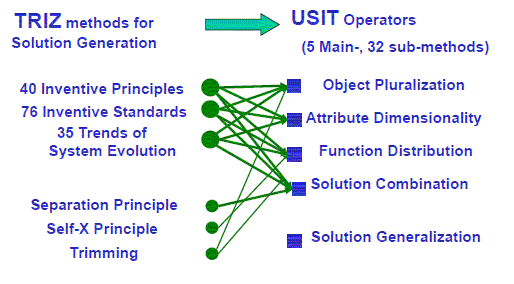
Fig. 7. All the solution generation methods in TRIZ were re-organized into the USIT Operator System. [12]
(3) In 2004, the present author drew the whole process of USIT in a data-flow representation in place of a flowchart representation. Then he realized that the data-flow diagram with 6 boxes represents a new basic paradigm of creative problem solving, and he named it the Six-Box Scheme (see 2.2.) [9, 10]. This finding gave USIT a solid base.
(4) In 2012, the present author considered over the future directions of proliferating TRIZ widely and deeply. He realized that the society really needs a system of general ways of thinking for creative problem solving and their supporting methods, instead of individual techniques. Then he called the system of methodology as CrePS (see 3.2) [5, 6]. He also found that the Six-Box Scheme best fits as the basic paradigm of the problem solving process in CrePS and hence a large variety of creative problem solving methods could be systematically integrated with the framework of the Six-Box Scheme into the CrePS methodology (see 2.2) [10]. Accordingly, USIT was regarded as 'a concise, easy-to-learn, general-purpose, whole process for executing the CrePS methodology' [7, 8, 13].
4.2 Possibility of integrating various methods by use of the Six-Box Scheme
By using the Six-Box Scheme as the framework, a large variety of methods for creative problem solving can be integrated systematically into the CrePS methodology. The outline of integration can be explained in terms of the categorization of approaches of such methods shown in Table 1 [9].
- Six-Box Scheme is an approach '(h) Towards a general methodology', and introduces '(a) Basics in science and technology' and '(b) Learning from cases' as the basic motives and in the form of knowledgebases.
- '(c) Analyzing problems and tasks' is incorporated in the Six-Box Scheme process in Box 1, Box 2, and Box3; similarly '(d) Supporting idea generation' in Box 4, and '(f) Realizing the ideas' in Box 5 and Box 6.
- '(g) Foreseeing the future' corresponds to the understanding of the ideal systems in Box3, and it also corresponds to an application theme of problem solving.
- '(e) Taking care of environmental and mental aspects' is introduced in the attitude of operating the whole process and also in some methods in CrePS.
The outlines described here are rough directions for integration. Actual work of integrating many and different methods into the CrePS methodology, however, is a big challenge for us.
4.3 USIT: A concise, easy-to-learn, whole process executing the Six-Box Scheme:
A whole process, which is concise, easy-to-learn, general-purpose, and executing along the Six-Box Scheme, already exists. That is USIT.
4.3.1 Overall view of the USIT process
The overall process of USIT is shown in Fig. 8 [6-8, 16]. The left column of Fig. 8 shows the 6 boxes along the main stream of the Six-Box Scheme, while the central column describes the main information to be obtained in each box in the USIT process. The right column shows the main process and principal methods used in USIT. The information of each box and the process of each step are more or less standardized in USIT for various problems, but may be adjusted depending on the problems.
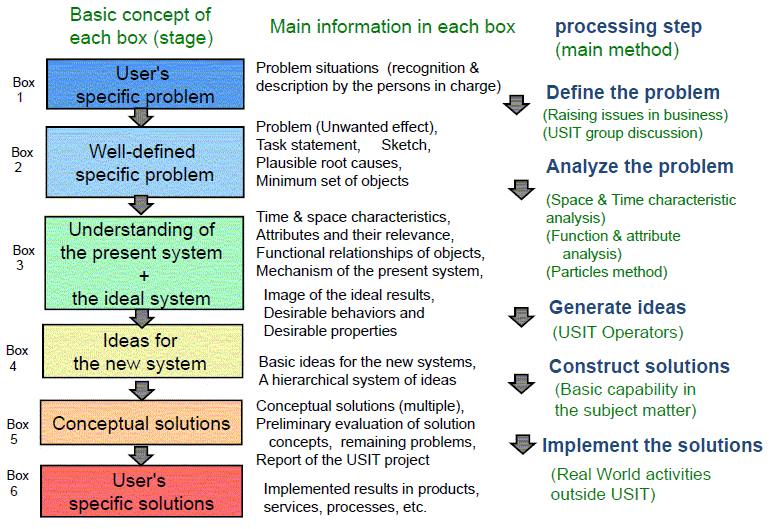
Fig. 8. Overall process of USIT:
Basic concepts of the 6 boxes, principal information to be obtained, and processing methods [16]
4.3.2 USIT Manual and Collection of USIT Case Studies
USIT Manual was made and publicized recently by re-describing the details of the processes which were mostly published so far [16]. A Collection of USIT Case Studies is also made and publicized [17]. It contains over 10 case studies of applying creative problem solving, which were published already by the present author (and some others), and were re-written recently in detail along the process and style of the USIT Manual. Including the above, a full set of CrePS/USIT documents (containing Reference list of CrePS/USIT, USIT Manual, Collection of USIT Case Studies, System of USIT Operators, etc.) are posted publicly in the "TRIZ Home Page in Japan" [18].
Fig. 9 is a list of 10 USIT Case Studies described both in Japanese and in English. Each case study is composed of about 20 slides and describes the full process of application according to the USIT Manual.
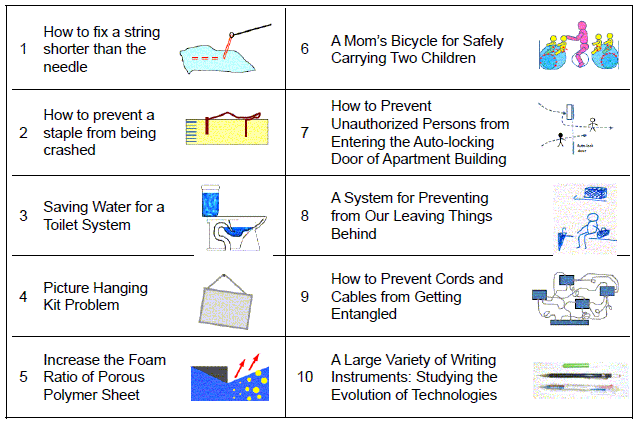
Fig. 9. 10 USIT Case Studies, which are described along the USIT Manual [17]
4.3.3 USIT Case Study: (4) Picture hanging kit problem
A standard case study in USIT is the Picture hanging kit problem (Case (4)). "In case of an ordinary simple system of hanging a picture with a string and a nail on the wall, the picture frame is likely to tilt afterwards. Improve the system/method so as the picture not likely to tilt." This case study was first talked by Ed Sickafus to high school students and then described in detail in his USIT textbook [11], and further revised several times by the present author [19].
This case study, as one of first runners, raised two methodological issues. How should we represent the attribute analysis and the functional analysis of the present system? and How can we generate various novel ideas smoothly and productively? The latter issue guided the present author and colleagues to develop the system of USIT Operators [12]. Recent work by the present author became to put more weight of this case study as an example of a physical contradiction problem. Namely, while adjusting the picture frame, the string must move smoothly on the nail, but after the adjustment, the string must not move on the nail. This is an example of a Physical contradiction. On this understanding of the problem, the criteria of selecting conceptual solutions were shifted to put emphasis on the resolution of the contradiction.
4.3.4 USIT Case Study: (3) Saving water on a toilet system: Solving a Physical contradiction
The case study shown in Fig. 10 was originally solved with TRIZ by H.S. Lee & K.W. Lee [20] and was re-described as a USIT case study by the present author [17]. Conventional flushing toilet system needs a lot of water for flushing away the stool. The original authors found the root cause in the S-shape pipe behind the basin, formulated the problem as a physical contradiction, and solved it with Altshuller's separation principle.
In the USIT process, at the stage of analyzing the present system from the aspect of time characteristics, the S-shape pipe is found to be an obstacle while flushing. Thus the S-shape pipe is useful usually, but it is harmful and should not exist while flushing. This finding of conflicting requirements is recognized as a case of physical contradiction (see lower part of Box 3). Then the ideal system is understood that the S-shape pipe exists at usual time periods while it disappears while flushing (see the upper part of Box 3).
In Box 4, an idea "The S-shape pipe should change its shape with respect to time (or condition of usage)" is easily obtained. Then a conceptual solution is constructed (see Box 5). Namely, the original authors made the S-shape pipe of flexible material and lifted it with a chain and a weight via a pulley. While usual time of no usage, the flexible pipe is lifted so as to keep water in the basin. When water is flushed, the part of flexible pipe becomes heavy with water and bends down on the floor. After the water and stool flow away, the part of the flexible pipe becomes empty and is lifted by the weight.
In this manner, the USIT process guides to recognize the conflicting requirements (i.e., Physical contradiction) smoothly at the early stage of analysis. USIT process in Box 3 and Box 4 naturally reflects the TRIZ method of Separation principle by Altshuller for solving Physical contradictions.
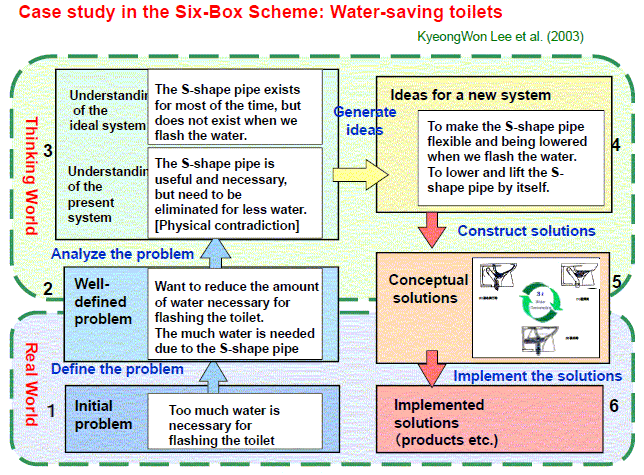
Fig. 10. USIT Case Study: (3) Saving water in a toilet system.
Overall view [17]: A Physical contradiction was solved with TRIZ (Originally by H.S. Lee & K.W. Lee [20])
The lesson of this case study is the merit of re-writing case studies which were solved by various authors with different methods and published already into USIT case studies along the Six-Box Scheme. Rewriting can express various case studies in the paradigm of the Six-Box Scheme and along the USIT process. The work of rewriting also guides us to understand better the method originally used in the case study. Such rewriting work is found useful for integrating and unifying various creative problem solving methods into the CrePS methodology.
4.4 Tasks for integrating various methods into the CrePS methodology. Problem recognition/definition and solution implementation in the Real World
For the purpose of integrating various creative problem solving methods, it is crucial to understand individual methods in the viewpoints of their application: namely, which application fields? what types of Real World?, what stages of activities? what purposes of problem solving? etc. We need to categorize and classify various methods (and their sub-methods and application cases) in these aspects of application. Corresponding to each category of application, we should devise suitable methods for the problem recognition/definition process (in the Real World), for the problem-solving process ( in a narrow sense) (in the Thinking World) and for the solution implementation process (in the Real World).
As Darrell Mann pointed out properly, the research front of the methodology of creative problem solving exists in the problem recognition/definition process in the Real World and in the solution implementation process in the Real World [21]. In such processes, there are a lot of issues which are not understood clearly and a lot of problem areas for which no suitable and effective solving methods are developed.
The Six-Box Scheme in the present paper locates these two processes in the Real World properly in the framework of the overall process of creative problem solving. And it also ensures the process of problem solving (in a narrow sense) in the Thinking World which exists in between and meaningfully connect the two processes in the Real World [21].
5. Concluding Remarks
5.1 What are made clear in the present work?
The following points have been made clear in the present work:
For the purpose of establishing the 'General Methodology of Creative Problem Solving (CrePS)', requirements for it and the target to pursue are clarified, and the basic plan of constructing it is made with the framework of the Six-Box Scheme as the paradigm.
Discussing why we need CrePS, it was pointed out that various conventional methods of creative problem solving do not have a solid framework and exist individually while competing with one another and hence they do not meet the needs of the society.
Further discussing how to construct CrePS, USIT was presented as a whole process for executing the Six-Box Scheme in a concise manner. USIT was adopted as the general purpose model of the creative problem solving process (in a narrow sense) in the Thinking world and the various conventional methods for creative problem solving can be categorized with respect to their application themes to constitute the problem definition process and the solution implementation process in the Real world.
5.2 Future tasks and challenges
There exist many more issues to consider further and many tasks to achieve in the near future. They are:
- The vision of CrePS and the new paradigm of Six-Box Scheme should be clarified further and should be shared widely.
- Case studies of solving different types of real problems with various creative problem solving methods should be collected, examined, and recorded systematically for the purpose of forming the bases of developing the CrePS methodology and its process.
- Various activities in different types of Real world should be categorized and modeled especially with respect to the problem definition process and the solution implementation process. And the process of creative problem solving in the Real world need to be developed.
- By learning and integrating various methods of creative problem solving, we should make the processes of executing the Six-Box Scheme in the Thinking world more effective, rich and yet easy to handle.
- Concepts, methods, tools, and documents related with CrePS should be publicized widely.
- And they should be proliferated widely in industries, academia, education, mass media/publishing, etc.
- Collaboration among the researchers, promoters, and users of various methods of creative problem solving should be realized.
References
[1] For example, Makoto Takahashi, ed. “Encyclopedia of Creative Capability, New Edition”, JUSE (2002) (Japanese)
[2] Genrikh S. Altshuller, “Creativity as an Exact Science: The Theory of the Solution of Inventive Problems”, Gordon and Breach Science Publishing, New York (1984)
[3] Yuri Salamatov, ed. Valeri Souchkov, “TRIZ: The Right Solution at the Right Time”, Insytec B.V., The Netherlands (1999); (Japanese Edition) Nikkei BP (2000).
[4] Darrell Mann, “Hands-On Systematic Innovation”, CREAX Press, Ieper, Belgium (2002); (Japanese Edition) SKI (2004); CrePS Inst. (2014).
[5] Toru Nakagawa, ‘Establishing general methodologies of creative problem-solving / task-achieving: Beyond TRIZ’, ETRIA TFC2012, Lisbon, Portugal, Oct. 24-26, 2012; TRIZ HP Japan, Dec. 2012 
[6] Toru Nakagawa, ‘General methodology for creative problem solving and task achieving (CrePS): Its vision’. ETRIA TFC2013, Oct. 29-31, 2013, Paris, France; THPJ, Oct. 25, 2013 (E) 
[7] Toru Nakagawa, ‘USIT: A Concise Process for Creative Problem Solving Based on the Paradigm of 'Six-Box Scheme’ -- USIT Manual and USIT Case Studies --‘, ETRIA TFC2015, Berlin, Germany, Oct. 26-29, 2015 

[8] Toru Nakagawa, ‘USIT: A Concise Process for Creative Problem Solving Based on the Paradigm of 'Six-Box Scheme’ -- USIT Manual and USIT Case Studies --‘, Journal of Japan Creativity Society, Vol. 19, pp. 64-84 (2015). 

[9] Toru Nakagawa: 'Overall Dataflow Structure for Creative Problem Solving in TRIZ/USIT', TRIZCON2005, Detroit, May, 2005; TRIZ Journal, May, 2005; TRIZ HP Japan, May, 2005. 
[10] Toru Nakagawa: 'A New Paradigm for Creative Problem Solving: Six-Box Scheme in USIT', ETRIA TFC2006, Kortrijk, Belgium, Oct. 6 - 8, 2006; TRIZ HP Japan, Nov. 2006 (E & J). 
[11] Ed N. Sickafus, “Unified Structured Inventive Thinking : How to Invent“, Ntelleck, Grosse Ile, MI, USA (1997).
[12] Toru Nakagawa, Hideaki Kosha, and Yuji Mihara: 'Reorganizing TRIZ Solution Generation Methods into Simple Five in USIT', ETRIA TFC2002, Strasbourg, France, Nov. 6-8, 2002; TRIZ HP Japan, Nov. 2002. 
[13] Toru Nakagawa, ‘General Methodology of Creative Problem Solving & Task Achieving (CrePS): Reorganizing Various Application Cases and Their Methods in the ‘Six-Box Scheme’’. ETRIA TFC 2014, Lausanne, Switzerland, Oct. 29-31, 2014; THPJ, Nov. 7, 2014 (E). 
[14] Darrell Mann, “Systematic Innovation: Past, Present and Future”, International Conf. on Systematic Innovation (ICSI 2015), Hong Kong, Jul. 15-17, 2015.
[15] Toru Nakagawa: 'Approaches to Application of TRIZ in Japan', TRIZCON2000, Nashua, NH, USA, Apr. 30 - May 2, 2000; TRIZ HP Japan, May 2000 (E & J). 
[16] Toru Nakagawa, ‘USIT Manual: USIT (Unified Structured Inventive Thinking): A Concise Process of Creative Problem Solving in the 'Six-Box Scheme'’, “TRIZ Home Page in Japan”, URL: http://www.osaka-gu.ac.jp/php/nakagawa/TRIZ/eTRIZ/eCrePS-USIT/eCrePS-USIT-Manual.html, May 23, 2015 (J), Jun. 26, 2015 (E) 
[17] Toru Nakagawa, ‘A Collection of USIT Case Studies: USIT (Unified Structured Inventive Thinking): A Concise Process of Creative Problem Solving in the 'Six-Box Scheme'’, “TRIZ Home Page in Japan”, URL: http://www.osaka- gu.ac.jp/php/nakagawa/TRIZ/eTRIZ/eCrePS/eCrePS-USIT/eCrePS-USIT-CaseStudies.html, May 23, 2015 (J), Jun. 26, 2015 (E) 
[18] Toru Nakagawa, ‘USIT Process Documents (Index): USIT (Unified Structured Inventive Thinking): A Concise Process of Creative Problem Solving in the 'Six-Box Scheme': USIT Manual, USIT Operator System, USIT Case Studies, USIT References’, “TRIZ Home Page in Japan”, URL: http://www.osaka-gu.ac.jp/php/nakagawa/TRIZ/eTRIZ/eCrePS/eCrePS-USIT/eCrePS-USIT-Doc.html, Jun. 26, 2015 (E) 
[19] Toru Nakagawa, Ed Sickafus, ‘Commentary on "The Picture Hanging Kit Problem"’, TRIZ HP Japan, (Aug. 2001) 
[20] Hong Suk Lee & Kyeong-Won Lee, ‘Practical Case Study of Resolving the Physical Contradiction in TRIZ; Super Water-Saving Toilet System Using Flexible Tube’, TRIZ Journal, Nov. 2002; TRIZ HP Japan, Jan. 2004, (J) 
[21] Darrell Mann, Toru Nakagawa, ‘Research focus is on problem finding and solution execution rather than problem solving (Mann) / Thinking methods for problem solving are the basis we should establish now (Nakagawa)’, TRIZ HP Japan, Nov. 2013. 
 Presentation Video (in English)
Presentation Video (in English)
Presentation Video: MP4 Format, 45 minutes, 801 MB, Recorded in Kashiwa, on Feb. 27, 2016
http://www.osaka-gu.ac.jp/php/nakagawa/TRIZ/Anime-Movies/TRIZCON2016/eTRIZCON2016-Nakagawa-CrePS-Video-160227.MP4  (MP4)
(MP4)
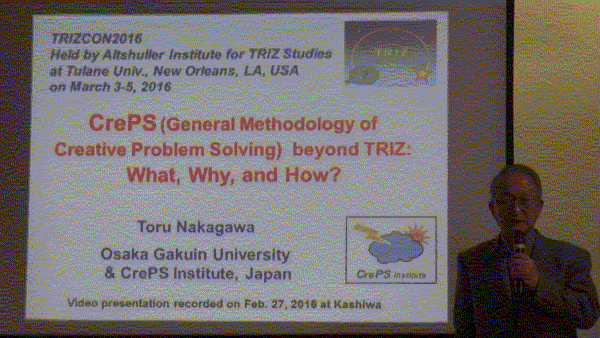

The Video file is now stored inside the present site of "TRIZ Home Page in Japan" located in the OGU Web server. The Video of 0.8 GB is added to the original HP of 0.9 GB, thanks to the generous permission by Osaka Gakuin University.
Last updated
on Jun. 27, 2016 Access point: Editor: nakagawa@ogu.ac.jp












































